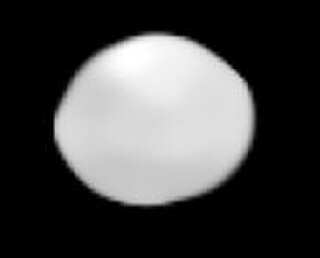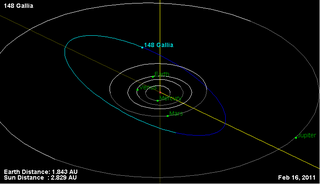Related Research Articles

Euphrosyne is a very young asteroid. It is one of the largest asteroids. It was discovered by James Ferguson on September 1, 1854, the first asteroid found from North America. It is named after Euphrosyne, one of the Charites in Greek mythology. In 2019 a small companion was discovered. It is the third-roundest known asteroid ; this is thought to be due to having re-accreted after being disrupted by a collision, and it is not close to hydrostatic equilibrium.

Gallia is an asteroid from the central regions of the asteroid belt, approximately 90 kilometers in diameter. It was discovered on 7 August 1875, by the French brothers Paul Henry and Prosper Henry at the Paris, but the credit for this discovery was given to Prosper. It was named after the Latin name for the country of France, Gaul. Based upon its spectrum, it is an unusual G-type asteroid (GU) and a stony S-type asteroid in the Tholen and SMASS classification, respectively.

Ophelia is a large, dark Themistian asteroid that was discovered by French astronomer Alphonse Borrelly on 13 January 1877, and named after Ophelia in Shakespeare's Hamlet.

Eucharis is a large, slowly rotating main-belt asteroid that was discovered by French astronomer Pablo Cottenot on February 2, 1878, from Marseille Observatory. It was his only asteroid discovery. This object was named after Eucharis, a nymph from the 17th-century novel Les Aventures de Télémaque.

Regina is a typical, although fairly large, Main belt asteroid. It was discovered by Auguste Charlois on 3 August 1889 in Nice, France. The asteroid is a suspected interloper in the Eucharis asteroid family.

Ornamenta is a relatively large main-belt asteroid, measuring 118 km in diameter. It is classified as a C-type asteroid and is probably composed of carbonaceous material.
945 Barcelona is a minor planet orbiting the Sun in the Asteroid belt. It was discovered 3 February 1921 from Barcelona by the Catalan astronomer Josep Comas i Solà (1868–1937) and named for the city of Barcelona (Spain), the birthplace of the discoverer. It has an estimated diameter of 25.5 km.

695 Bella is a minor planet orbiting the Sun.
729 Watsonia is a rare-type asteroid and namesake of the Watsonia family from the central region of the asteroid belt. It was named after the Canadian-American astronomer James C. Watson. Watsonia occulted the star 54 Leonis on 2013 Mar 03 at 01:48.
780 Armenia is a minor planet in the asteroid belt orbiting the Sun. It is named after the Kingdom of Armenia, now Armenia. This object is orbiting at a distance of 3.11 AU with an eccentricity of 0.097 and a period of 5.50 yr. The orbital plane is inclined at an angle of 19.1° to the plane of rotation. This asteroid spans a girth of ~94 km. The long rotation period of this asteroid necessitated light curve data from more than one latitude. The overlapping data provided a solution with a period of 19.891±0.002 h and a brightness amplitude of 0.18±0.03 in magnitude.
781 Kartvelia is a minor planet orbiting the Sun that was discovered by Russian astronomer Grigory Neujmin on January 25, 1914. Kartvelia comes from the historic name for the inhabitants of the nation of Georgia. This object is orbiting at a distance of 3.22 AU with an eccentricity (ovalness) of 0.12 and a period of 5.78 yr. The orbital plane is inclined at an angle of 19.1° to the plane of the ecliptic.
51829 Williemccool, provisional designation 2001 OD41, is a Vestian asteroid from the inner regions of the asteroid belt, approximately 2 kilometers in diameter. It was discovered on 21 July 2001, by astronomers of the Near-Earth Asteroid Tracking program at Palomar Observatory in California, United States. The asteroid was named in memory of American astronaut and pilot William C. McCool, who died in the Space Shuttle Columbia disaster.
1101 Clematis is an Alauda asteroid from the outermost regions of the asteroid belt, approximately 37 kilometers in diameter. It was discovered on 22 September 1928, by German astronomer Karl Reinmuth at the Heidelberg-Königstuhl State Observatory in southwest Germany, and assigned the provisional designation 1928 SJ. It was named for the flowering plant Clematis. The presumably carbonaceous asteroid has a relatively long rotation period of 34.3 hours.
9069 Hovland, provisional designation 1993 OV, is a stony binary Hungaria asteroid from the inner regions of the asteroid belt, approximately 3 kilometers in diameter.

1508 Kemi, provisional designation 1938 UP, is an eccentric, carbonaceous asteroid and one of the largest Mars-crossers, approximately 17 kilometers in diameter. Discovered by Heikki Alikoski at Turku Observatory in 1938, the asteroid was later named after the Finnish town of Kemi and the Kemi River.
4832 Palinurus is a Jupiter trojan from the Trojan camp, approximately 52 kilometers in diameter. It was discovered on 12 October 1988, by American astronomer Carolyn Shoemaker at the Palomar Observatory in California. The dark D-type asteroid belongs to the 90 largest Jupiter trojans and has a short rotation period of 5.3 hours. It was named after Aeneas' navigator, Palinurus, from Greek mythology.
1222 Tina, provisional designation 1932 LA, is a metallic asteroid and parent body of the Tina family located in the intermediate asteroid belt, approximately 25 kilometers in diameter. It was discovered on 11 June 1932, by Belgian astronomer Eugène Delporte at Uccle Observatory in Belgium. It was named after a friend of the discoverer.
2903 Zhuhai, provisional designation 1981 UV9, is a stony background or Marian asteroid from the central regions of the asteroid belt, approximately 14 kilometers (8.7 miles) in diameter. It was discovered on 23 October 1981, by astronomers at Purple Mountain Observatory near Nanking, China. The S-type asteroid has a rotation period of 5.26 hours. It was named for the Chinese city of Zhuhai.
(11436) 1969 QR, is a stony Florian asteroid from the inner regions of the asteroid belt, approximately 3.7 kilometers in diameter. It was discovered on 22 August 1969, by Czech astronomer Luboš Kohoutek at Bergedorf Observatory in Hamburg, Germany.

2011 SP189 is a small asteroid and Mars trojan orbiting near the L5 point of Mars (60 degrees behind Mars on its orbit).
References
- ↑ Yeomans, Donald K., "686 Gersuind", JPL Small-Body Database Browser, NASA Jet Propulsion Laboratory , retrieved 5 May 2016.
- ↑ Novaković, Bojan; et al. (November 2011), "Families among high-inclination asteroids", Icarus, vol. 216, no. 1, pp. 69–81, arXiv: 1108.3740 , Bibcode:2011Icar..216...69N, doi:10.1016/j.icarus.2011.08.016.